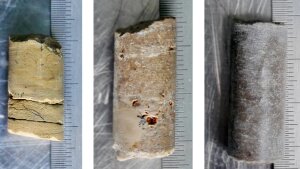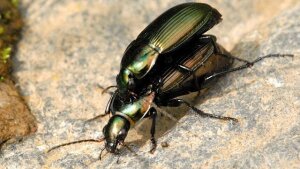Ticker
DNA from the past
Rock cores used for the investigation.
Image: Robert LehmannThe majority of microbial biomass in the Earth system is hidden below ground. Estimates suggest that microorganisms could extend to a depth of five kilometres below the surface and are also capable of colonizing solid rock. Given the difficulty in accessing this deep biosphere, researchers have learned little to date about the composition of these microorganisms and their role in biogeochemical cycles.
A research team led by Prof. Dr Kirsten Küsel and Prof. Dr Christina Warinner at the »Balance of the Microverse« Cluster of Excellence has now discovered that chalk serves as an archive of underground microbial communities. The initial results of the study have been published in the specialist journal »Microbiome« (DOI: 10.1186/s40168-023-01647-2External link). [Gold/Nieber]
Hydrogen through sunlight
Prof. Dr Kalina Peneva and her doctoral student Konrad Hotzel are investigating functional dyes.
Image: Anne Günther (University of Jena)Sustainable, sunlight-powered hydrogen production relies on a catalyst system that is not only efficient but, ultimately, also cost-efficient, widely available and resource-friendly. A team led by Prof. Dr Kalina Peneva (photo above, left) of the Institute of Organic Chemistry and Macromolecular Chemistry has now taken a step in this direction.
Her group has developed dyes that can make do without metals, are easy to produce and transfer absorbed light energy to a catalyst, which then produces hydrogen. The team has published their results in »Journal of Materials Chemistry A« (DOI: 10.1039/D3TA04450EExternal link). The article describes not only the dyes but also their interactions with the catalyst. [MK]
Resistant starch as a prebiotic
Resistant starch may play an important role in the treatment of non-alcoholic fatty liver disease in the future.
Image: stock.adobe.comResistant starch, which can be found in whole-grain cereals, legumes, green bananas and potatoes, could have an important role to play in the future treatment of non-alcoholic fatty liver disease. The results of a study led by Prof. Dr Gianni Panagiotou at the »Balance of the Microverse« Cluster of Excellence show that a diet featuring resistant starch can not only have a positive impact on the gut microbiome but also ease the course of the illness.
The researchers identified reduced fat build-up in the livers of test subjects and also observed an increase in certain types of intestinal bacteria that positively influence the breakdown and transport of fat in the liver. The results have been published in »Cell Metabolism« (DOI: 10.1016/j.cmet.2023.08.002External link). [Nieber]
Insects on the retreat
Predatory beetles are among the insect populations with the sharpest population declines.
Image: J. LindseyThe decline in terrestrial insects like beetles, moths and grasshoppers can be attributed above all to the loss of locally abundant species. These are the findings of a current study (DOI: 10.1038/s41586-023-06861-4External link). Led by researchers from the German Centre for Integrative Biodiversity Research (iDiv), Martin Luther University Halle-Wittenberg and the University of Jena, this meta-analysis of 923 sites around the world highlights two key tendencies.
Firstly, abundant species with many individuals have declined more significantly than rare species. Secondly, the increases in some insect species have been too small to achieve previously observed levels of abundance. This confirms the widespread observation that there are fewer insects today than was the case 10, 20 or 30 years ago. The analysis reviewed 106 studies running for periods of up to 64 years. [Coester/iDiv]
Mummies under the microscope
Dr Enrico Paust looks at glued textile fragments from an Egyptian mummy.
Image: Jens Meyer (University of Jena)The archives of the University of Jena contain a wealth of artefacts—including around 20 mummy fragments. Researchers from the fields of biology, medicine and the archaeology of prehistory to the Middle Ages have now examined these fragments for the first time, presenting their findings in »Annals of the History and Philosophy of Biology« (DOI: 10.17875/gup2023-2486External link).
They include four skulls, a torso fragment, a pelvis, two lower jaws, two groups of vertebrae, three left feet and some tissue remains from Egyptian mummies, as well as two child mummies from South America which are almost completely preserved. The leader of the study, Dr Enrico Paust, says that it is not yet possible to say for certain where these artefacts came from, the circumstances under which they were found or how they came to Jena. [sh]
Planets between multiple suns
Artist's impression of the Gaia space probe with the Milky Way in the background.
Illustration: ESA/ATG medialab; background image: ESO/S. BrunierKai-Uwe Michel and Dr Markus Mugrauer of the Institute of Astrophysics of the University of Jena have conducted a study examining how many stars with extrasolar planets (exoplanets) have one or even more companion stars, and what impact this stellar multiplicity has on the properties of planet systems.
The researchers drew on observation data from the Gaia space observatory (image) operated by the European Space Agency, examining more than 2,200 exoplanet hosts for possible companion stars. They made a find with roughly every fifth exoplanet hosts. In total, the astrophysicists have demonstrated the existence of several hundred new companion stars, as they reported in »Monthly Notices of the Royal Astronomical Society« (DOI: 10.1093/mnras/stad3196External link). [US]
Alone doesn't necessarily mean lonely
Walking alone. Around 20 per cent of German adults live alone.
Image: Jens Meyer (University of Jena)Around 20% of Germans live alone—and this figure is on the way up. In fact, this trend can be observed in most Western countries. Yet, despite prevailing preconceptions to the contrary, living alone does not necessarily entail isolation and loneliness. These are the findings of a team led by psychologist Prof. Dr Franz Neyer of the University of Jena, with the results detailed in the »International Journal of Behavioral Development« (DOI: 10.1177/01650254231206329External link).
The researchers surveyed around 400 people aged between 35 and 60 over a three-year period. Around one-third of those surveyed were particularly pleased to have an extensive network to draw on and engage with different social contacts on a daily basis, including friends and family as well as acquaintances such as work colleagues and neighbours. [sh]
Artificial light threatens ecosystems
The iDiv-EcoTron was used in several studies to simulate and change the lighting conditions at night.
Image: Myriam HirtA collection of studies into artificial light at night has demonstrated that the impacts of light pollution are more extensive than previously thought. Even small quantities of artificial light can disrupt species communities and entire ecosystems. A special issue published in the journal »Philosophical Transactions of the Royal Society B« focuses on the effects of light pollution on complex ecosystems, including soil, grassland and insect communities.
Researchers at the German Centre for Integrative Biodiversity Research (iDiv) and the University of Jena contributed to the publication, describing the domino effect that light pollution can have on ecosystem functions and stability. Dr Myriam Hirt and Dr Remo Ryser served as senior editors on the issue. [Coester/iDiv]



